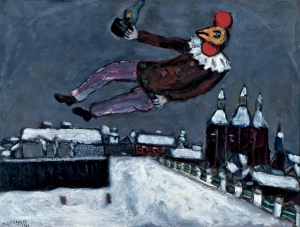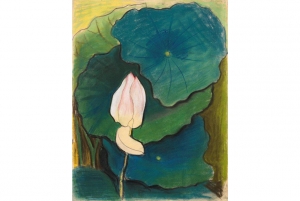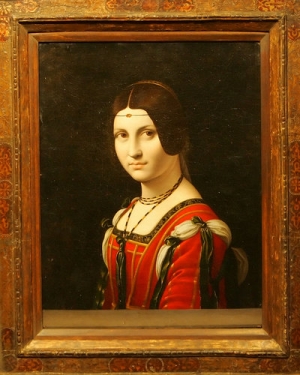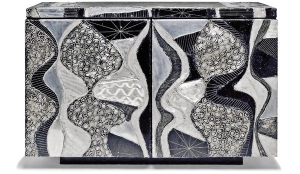|
Displaying items by tag: Modernism

During a career that spanned much of the 20th century, Russian artist Marc Chagall (1887-1985) was associated with a number of artistic movements, making a name for himself as a pioneer of modernism. Considered one of the most successful artists of his time, Chagall drew inspiration from his Orthodox Jewish upbringing, a theme that prevailed through the many mediums and styles he explored.
The Musee de Luxembourg in Paris has organized an exhibition devoted to the artist titled Chagall: Between War and Peace. The show, which focuses on Chagall’s work between 1914, when he developed his own style, and the mid-1950s, when many critics deemed his work repetitive, includes approximately 100 oil paintings, watercolors, drawings and etchings in relatively chronological order.
Between War and Peace is broken into four pivotal periods in Chagall’s life and work. After living in Paris from 1910 to 1914 and associating with many prominent figures of the avant-garde, Chagall returned to his native Russia to be with his future wife, Bella. “Russia in Wartime” explores Chagall’s work from this period, which was haunted by the brutality and horrors that World War I brought to his homeland.
In 1922, Chagall left Russia for Berlin. He soon returned to Paris where he re-established himself as a painter. “Between the Wars” focuses on this period, which includes Chagall’s work as an illustrator. Many of the pieces from this time feature landscapes, portraits of the artist with his wife, circus scenes, and hybrid creatures, which are prime examples of Chagallian bestiary.
In 1937, Nazis seized any works by Chagall that resided in public collections in Germany. As World War II unfolded, Chagall left France for New York, which is the subject of “Exile in the United States.” His work took a somber turn as his native land was ravaged by the war. A particularly productive time for Chagall, he also created a number of works devoted to Bella, who died in 1944.
The exhibition’s final portion, “The Post-War Years and the Return to France,” explores Chagall’s move back to Europe in 1949. During this time Chagall experimented with stained glass, sculpture, ceramics, mosaic, and various engraving techniques. His works from this period radiates with light and emotional tonalities.
Chagall: Between War and Peace is on view through July 21, 2013.
Suspended Forms: American Modernism 1908-1928 opened yesterday, January 31, 2013 at Driscoll Babcock Galleries in New York and will run through February 16, 2013. The exhibition focuses on American modern art’s earlier phase and includes paintings and drawings by modern masters such as Alfred Maurer (1868-1932), Walt Kuhn (1877-1949), Stuart Davis (1892-1964), Charles Burchfield (1893-1967), Marsden Hartley (1877-1943), Charles Sheeler (1883-1965), and Joseph Stella (1877-1946).
Suspended Forms will be held at Driscoll Babcock’s relatively new location in Chelsea. Founded 160 years ago, Driscoll Babcock Galleries moved from its former Fifth Avenue location to Chelsea in September 2012.

100 years after the seminal Armory Show in New York City, The Heckscher Museum of Art presents Modernizing America: Artists of the Armory Show. On view through April 14, 2013, the exhibition features works from the museum’s permanent collection and explores the show that changed the country’s perception of modern art.
Organized by the Association of American Painters and Sculptors, the Armory Show, officially titled the International Exhibition of Modern Art, took place at the 69th Regiment Armory and introduced radical works of art to the public; a far cry from the realistic art they were accustomed to. Artists, critics, and patrons were presented with European works that boasted avant-garde sensibilities and spanned genres like Futurism, Cubism, and Fauvism. The show transformed the landscape of modern art and inspired an unmatched growth and progression in American art.
Works on view include paintings by Marguerite Zorach (1877-1968) and Arthur B. Carles (1882-1952); works on paper by Joseph Stella (1877-1946), Oscar Bluemner (1867-1938), and Charles Sheeler (1883-1965); and sculptures by artists such as Walter Kuhn (1877-1949).
The Heckscher Museum of Art was founded in 1920 by August Heckscher in Huntington, New York. The museum boasts over 2,000 works and focuses mainly on American landscape paintings as well as American and European modernism and photography.
The archives of Frank Lloyd Wright, widely regarded as one of the greatest architects of modern times, will move to New York City to become part of the permanent collections of Columbia University and the Museum of Modern Art, the institutions announced on Tuesday.
The Frank Lloyd Wright Foundation said its decision to work with MoMA and Columbia would ensure the archives, including more than 23,000 of Wright's architectural drawings, are properly conserved and seen more widely by scholars and the public.
Wright died in 1959 at the age of 91.
"This is all part of our cultural heritage," said Sean Malone, the foundation's CEO. The foundation has spent the past two years deciding how to conserve the archives, he said.
Christie’s New York has announced that two classic works on paper by Norman Rockwell will lead its American Art auction in September.
One of the Rockwell drawings, Study for ‘The Runaway,’ illustrates a young boy and a policeman sitting side by side at the counter of a coffee shop and is one of the artist’s most iconic images. Underneath the boy’s seat is a bag containing his belongings as he is preparing to run away from home. The policeman, in a friendly manner, tries to talk the child out of his departure. The completed work was used as a Saturday Evening Post cover on the Sept. 20, 1958, issue. The piece is expected to bring in $80,000 to $120,000.

Federal District Court Judge Paul G. Gardephe’s résumé includes many impressive accomplishments but not an art history degree. Nonetheless he has been asked to answer a question on which even pre-eminent art experts cannot agree: Are three reputed masterworks of Modernism genuine or fake.
Judge Gardephe’s situation is not unique. Although there are no statistics on whether such cases are increasing, lawyers agree that as art prices rise, so does the temptation to turn to the courts to settle disputes over authenticity. One result is that judges and juries with no background in art can frequently be asked to arbitrate among experts who have devoted their lives to parsing a brush stroke.
The three cases on Judge Gardephe’s docket in Manhattan were brought by patrons of the now-defunct Knoedler & Company who charge that the Upper East Side gallery and its former president Ann Freedman duped them into spending millions of dollars on forgeries.
The judge’s rulings may ultimately rely more on the intricacies of contract law than on determinations of authenticity. But the defendants and plaintiffs are busily assembling impressive rosters of artistic and forensic experts who hope to convince the judge that the works — purportedly by Jackson Pollock, Willem de Kooning and Mark Rothko — are clearly originals or obvious fakes.
Of course judges and juries routinely decide between competing experts. As Ronald D. Spencer, an art law specialist, put it, “A judge will rule on medical malpractice even if he doesn’t know how to take out a gallstone.” When it comes to questions of authenticity, however, lawyers note that the courts and the art world weigh evidence differently.
Judges and juries have been thrust into the role of courtroom connoisseur. Legal experts say that, in general, litigants seek a ruling from the bench when the arguments primarily concern matters of law; juries are more apt to be requested when facts are in dispute.
H. G. Wells, writing this passage in 1933, knew that he was living in a time of absolute and unprecedented transformation. People's daily lives were changing, and this filled the great author and futurist with both excitement and foreboding. He saw that, given the extraordinary new powers science had delivered, humanity might perfect the world or use these new capabilities to bring about total annihilation.
Wells was living in the nervous and frenetic time that fell between the grim bookends of two World Wars. Technologically, this was not an especially innovative period. The electric light bulb, the automobile, the airplane, the skyscraper, the radio, and the telephone all predate World War I. It was a time of development and dispersal rather than invention; it was during the period between the two World Wars that these life-changing technologies became widespread.
Since the late nineteenth century, California’s Monterey Peninsula and its wondrous landscape has been a magnet for artists: Its first art colony was settled in 1875 by Jules Tavernier, making it one of the longest established art colonies in the country. Once the Southern California Pacific’s Del Monte Express Railroad and the Hotel Del Monte were completed in 1880, tourism boomed and people from all over the United States came to the Peninsula. The public was exposed to a new lifestyle, new terrain, and local artists—subjects never seen in California painting before the works were exhibited in the hotel’s art gallery in 1907.
Hand-made objects, long subservient to an artificial hierarchy of the arts established in the Renaissance, underwent a paradigm shift in the postwar period, defined here as 1945 to 1969, and became an assertive form of artistic expression. Craftspeople found affirmation in the creations of Alexander Calder and Isamu Noguchi, who roamed freely across media and disciplines without regard for superficial divisions. The changed status of craft was not widely accepted by the fine arts world, but the altered relationship was nevertheless made plain by those who appropriated craft-based materials and techniques into aspects of postwar art, and by craftspeople whose work addressed such fine-arts concerns as process, form, and content (Fig. 1).

In a buying spree that lasted just half a decade, John R. Eckel Jr. built a collection of Modernist furniture and paintings that museums craved. Mr. Eckel, a Houston energy tycoon who died in 2009, focused on a few American designers and artists, including Paul Evans, Harry Bertoia and Edward Wormley.
Before his death at 58, Mr. Eckel told colleagues that his hundreds of pieces should be used to benefit the Whitney Museum of American Art and the Museum of Fine Arts, Houston.
On Saturday the Houston museum plans to unveil about 70 objects in “The Spirit of Modernism: The John R. Eckel Jr. Foundation Gift to the Museum of Fine Arts, Houston.” (The foundation is giving about two dozen artworks to the Whitney, including Los Angeles photos by Ed Ruscha, and Bertoia bundles of copper strands.)
In Houston, Bertoia metal spires up to 12 feet tall will tower over Evans cabinets fronted in a patchwork of steel and slate, and a triangular Wormley table inlaid with Tiffany glass tiles.
Mr. Eckel had bought what he liked, in depth, without much input from advisers. “He always relied on himself,” said Douglas L. Lawing, president of the new foundation, which will support arts groups and other charities.
Now that curators have chosen donations from Mr. Eckel’s homes and storage spaces in New York and Houston, the foundation has been consigning objects and paintings at Wright auction house in Chicago, one of this collector’s favorite sources over the years.
On June 28 Wright offered 241 lots from the Eckel estate. The four- and five-figure prices mostly met or surpassed what he had originally paid at the auction house.
Richard Wright, the company’s owner, said that handling the material again so soon helped improve scholarship in the young collecting field of Modernism, laying out provenance trails and value precedents. “There’s a certain beauty to that, to see history being built in a field that’s relatively new,” he said.
YES, WE HAVE BUNCHES OF BANANAS
Artifacts related to bananas, whether vintage fruit bowls or plantain refrigerator magnets, are taking over a yellow concrete storefront in the Southern California desert. The International Banana Museum is scheduled to open in October on the shores of the Salton Sea, a salty inland lake in Mecca, Calif.
The museum’s proprietor, Fred Garbutt, a tennis court contractor, bought the collection of 17,000 pieces last year, with his mother, Virginia. The seller, Ken Bannister, a real estate broker, had begun acquiring all manner of banana memorabilia in the 1970s and long ran a themed museum in Hesperia, in the Mojave Desert. Mr. Garbutt declined to disclose how much he and his mother had paid. The widely reported asking price was $7,500.
Mr. Garbutt has set up the displays in a former pizza parlor, next to a liquor and bait store that his family has owned since the 1950s. Alongside stools shaped like banana plants, he is organizing the cases by object types, including games, statuettes and cooking utensils.
Visitors are welcome to make puns about the attraction’s a-peel and slipperiness and its split with the Bannister version. “I don’t think that’ll ever get old,” Mr. Garbutt said in a recent phone interview.
He said he planned to serve banana-flavored milkshakes, muffins and ice cream and charge a dollar or two admission. Mr. Garbutt also said he would seek sponsorships from corporate banana growers.
Tours can be arranged via e-mail to This email address is being protected from spambots. You need JavaScript enabled to view it..
|
|
|
|
|